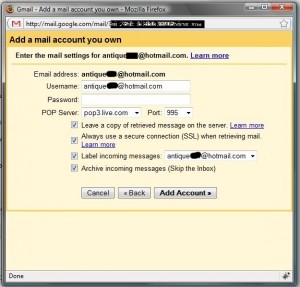GMail Drive is what’s known as a shell extension for Windows. Since I don’t know what a shell extension is, you don’t have to either. Just use GMail Drive as I do and you’ll have seven gigabytes and counting of free online storage.
1. Download GMail Drive from here This is the url, in case you are paranoid :http://www.viksoe.dk/code/gmail.htm
2. GMail comes as a zip file so unzip it and install it, then reboot as per the instructions. You have to reboot because GMail Drive actually adds a virtual drive to your computer. More on that later.
3. Once you’ve rebooted, start up Internet Explorer. Don’t ask me why this is one of the steps but it is. GMail Drive does not work unless you have Internet Explorer running in the background. If you don’t have Internet Explorer running, you will get an error message on login which suggests that gmail has changed it’s permissions. This is NOT the case. GMail Drive still works, you just have to have Internet Explorer running in the background.
4. Now for the cool part. Right click START, then choose EXPLORE. Down at the bottom left side, under your hard drives, DVD/CD drives and removeable drives, you will see GMail Drive. Right click it and choose Login As. The typical menu pops up and you enter your gmail account name as well as your password, then click AutoLogin if you are on a secure computer and you’re done.
5. GMail Drive is now, essentially, part of your computer. Go back to your desktop and right click a picture, or a song, or a document. Under the Send To option you will now have a GMail Drive choice. If you are logged in to your gmail account you can now right click a file and ‘send it’ to your gmail account.
6. There are some limitations to all of this. First the file has to be under 20 megabytes. Officially the limit is 20 megs but unofficially the limit is about 24. Second, you can’t send every mp3 on your computer to your gmail account at one time. Select a few, send them up and wait. Lather, rinse, repeat, right?
Now, thanks to GMail Drive, you can share pics, music or just about anything with friends or just with yourself. One of the way I use my gmail accounts is to share tunes with friends around the world. Say I meet Etsuko in Japan. If she wants to listen to my tunes and I want to listen to hers, then we get a new gmail account and share it. Etsuko uploads her tunes through GMail Drive while I upload mine the same way. One of the terrific benefits of gmail is that you don’t have to download an MP3 to play it. Gmail has a player built right into it. Click on a tune, wait for a second until gmail scans it for viruses then click PLAY. The MP3 plays right there in your gmail account.
GMail Drive is a quick and easy way to access your gmail account from your computer. Try it! You’ll like it!

